Unit 26: What is Discrete Trial Training (DTT) in ABA School Readiness for Children with Autism

Discrete Trial Training (DTT) is one of the critical components of Applied Behavior Analysis (ABA) and provides a systematic method to teach children with autism important skills. It is an evidence-based ABA Technique that has been developed to serve the special requirements of children on the autism spectrum, by focusing on one-on-one teaching and positive reinforcement. Discrete Trial Training in ABA enables children to learn new skills by breaking complex tasks into smaller portions. The DTT integration with autism treatment is a holistic approach to early intervention, which allows children to prepare for school and life-long learning. This post discusses major concepts of DTT as part of ABA emphasizing its significance in structured teaching and enabling children with autism to deal with future educational challenges.
Definition of Discrete Trial Training (DTT)
Discrete Trial Training (DTT) also referred to as Discrete Trial Teaching is a very structured instructional method used in the context of Applied Behavior Analysis (ABA) to teach children with Autism Spectrum Disorder (ASD) and other developmental delays. DTT is about situation skills into the smallest steps and teaching each step of the competence intensely until mastery. Each discrete trial consists of three main components: the antecedent (a simple instruction or cue given by the therapist), the response (the behavior or action performed by the student in reaction to the antecedent), and the consequence (feedback provided by the therapist consequent to the student’s response). This approach permits targeted learning sessions where individual behaviors and responses can be isolated, observed, and reinforced.
Dr. Ivar Lovaas, who was an unmatched figure in the field of Applied Behavior Analysis (ABA), was the founder of Discrete Trial Training (DTT) during the 1960s and 70s. His work at UCLA made DTT a critical aspect of behavioral therapy for autistic children. Lovaas demonstrated the importance of Early Intervention and intensive therapy, showing that organized ABA procedures such as DTT can result in significant progress in learning and behavior for children with autism.
Purpose of Discrete Trial Training
The major goal of Discrete Trial Training in ABA is to help Children with Autism and developmental disorders learn skills that might be difficult to learn in a different way. DTT breaks tasks down into steps, thereby facilitating learning. It provides instant feedback aimed to promote good behaviors and to rectify errors that lead children to the right outcome. The mission of DTT is to equip children with basic independent skills, Improved Communication, and social interaction thus, making them take part in everyday activities and natural learning environments.
What Makes Discrete Trial Training Especially Effective for Children with Autism?
Children with autism benefit greatly from Discrete Trial Training (DTT) which is characterized by an individualized and structured approach that suits their learning style. This method is beneficial for several reasons:
- This divides complex assignments into smaller, manageable tasks that help in understanding and mastery.
- DTT has a controlled and repetitive nature, reduces distractions and improves focus.
- Positive Reinforcement brings towards active participation and motivation that result in behavior change and skill acquisition.
- DTT is widely used in teaching speech, language, and communication skills necessary for conversations, sign language, or using communication devices.
- It also focuses on fundamental life skills like dressing, using cutlery, following instructions, and acquiring writing skills.
Children with autism have impairments in generalized learning, communication, and social interaction, which negates the value of traditional education methods. DTT’s systematic approach addresses these problems, facilitating the acquisition of basic life skills and enhancing cognitive and academic skills. This gets children ready for better development and School Readiness.

Components of Discrete Trial Training
Discrete Trial Training (DTT) in ABA is characterized by its discrete components, each of which is an essential part of learning for children with autism. Understanding these components is crucial for implementing DTT effectively:
1️⃣ Antecedent
This is the prime cue or incitement given by the Therapist or teacher. The antecedent works to indicate the commencement of a trial and requires a particular reaction from the student. This could be verbal as in direct command (“Touch red”) or non-verbal, for instance, gestures, visual cues, or physical objects.
2️⃣ Response
The response is what the child does in response to the antecedent. It demonstrates the child’s effort to follow the instructions provided. The child’s responses may be quite different, from correct to incorrect, or the child may not respond at all.
3️⃣ Consequence
After the child’s answer, the therapist gives a consequence. Within DTT, the consequences are usually positive reinforcement (i.e., praise, tokens, or access to preferred activities), which is given to strengthen correct responses and promote the repetition of behavior. If a response is wrong or there is no response, no reinforcement (correction procedures) may be given, followed by another trial with more prompting or with a simpler task that guarantees success.
4️⃣ Prompting
Prompting is frequently incorporated into DTT sessions where it includes giving more cues or support for the correct answer. Prompts may be physical (orienting the child’s hand), verbal (a clue), visual (a picture), or gestural (nodding or pointing). The objective is to decrease prompts slowly and finally, remove them as the child becomes capable of completing the task in an independent way.
Integrating all these components, DTT offers a complete model for teaching and practicing new skills and behaviors, which is why it is a strong intervention among others for helping children with Autism Spectrum Disorder.

Benefits of Discrete Trial Training in Enhancing School Readiness
Discrete Trial Training (DTT) has a huge positive impact on children with autism, helping them get ready for school by providing a strong basis for academic and social development. Here’s how DTT promotes school readiness:
Skill Acquisition
DTT focuses on essential school skills right from the basics such as numbers and letters to more intricate tasks of following instructions and completing tasks. Skills are then reduced to manageable steps for mastery.
Behavioral Improvements
DTT’s systematic approach minimizes challenging behaviors by setting clear rules and routines, connecting positive behaviors with rewards and improving efficiency in education environments.
Social Skills Development
DTT also enhances social interactions and communication, teaching children to start a conversation, wait their turn and participate in group activities, which is vital for school.
Increased Independence
With the mastery of tasks and building self-esteem, DTT develops independence in children which is the most important virtue in school because they need to control tasks and belonging with minimal adult help.
Enhanced Attention and Focus
Attention span and focus, necessary for meeting academic challenges, are improved by DTT, by teaching concentration, instruction following, and distraction resistance.
Generalization of Skills
DTT promotes the use of skills in different contexts, which is essential for the transfer of skills from therapy to school.
Preparation for Structured Learning
DTT is about the structure of the school day and what children are expected to do in terms of following directions, finishing tasks on time, and group participation.
In summary, DTT is essential for getting children with autism ready for school and for ensuring their educational and personal growth.
Limitations of Discrete Trial Training
While Discrete Trial Training is a key tool in Autism Intervention, recognizing its limitations ensures a balanced approach to therapy and education:
Lack of Generalization
One of the main critiques of DTT is that the skills learned within its structured environment do not transfer to other settings if generalization strategies are not specifically taught.
Motivation and Engagement
Such repetitive phenomena in DTT can decrease the motivation and engagement of some learners, especially those who require various and interactive learning to keep their interest.
Social Interaction
Although adaptable for teaching social skills, DTT is individual-centered, which may diminish natural interaction with peers, which is important for social development and school readiness.
Flexibility and Creativity
The structured nature of DTT may lack spontaneous interaction and creative problem-solving, leaving children in situations that require flexibility or creativity.
Holistic Development
An excessive emphasis on DTT may ignore other developmental areas such as emotional regulation, play skills, and informal learning settings that are as important for a child’s holistic development.
Understanding these constraints is crucial to practitioners and educators in integrating Discrete Trial Training with other approaches and interventions which provides a wider developmental process for children with autism.

Integration of Discrete Trial Training with School Readiness Skills
Combining ABA Discrete Trial Training with School Readiness skills is a systematic approach to preparing children with autism for the academic and social challenges they will face in school. Emphasizing communication, rudimentary academics, social interaction, and self-care, it can be customized to satisfy the minimal conditions for school participation. This method uses well-organized sessions to teach the basic readiness skills in stages so that the child has to master each skill before the next one is introduced.
Further, the use of generalization strategies in DTT enables the children to transfer the skills to different environments that mirror what they will encounter in school. This teaching has positive reinforcement that elevates the motivation level thus making the learning fun and productive. Readiness for both academic and social aspects can be addressed in children with autism by covering Discrete Trial Training within ABA Therapy, allowing educators and therapists to establish a well-prepared community for children with autism and support the long-term success of such a community.
Join Our Weekly Newsletters!
Subscribe now to stay updated with our latest email updates.
Comparison Between DTT and NTS
Discrete Trial Training (DTT) and Naturalistic Teaching Strategies (NTS) or Incidental Teaching, represent two different teaching strategies in ABA for teaching skills to the learners.
✔️ DTT is a highly structured teaching method, ideal for teaching basic skills through repetition and accuracy and ensuring fast mastery and consistent feedback.
✔️ On the contrary, Naturalistic Teaching Strategies and Incidental Teaching are characterized by learning in natural settings, active participation, and the generalization of skills through the use of the learner’s preferences and incentives.
✔️ DTT serves as a base to help in skill acquisition while NTS allows for the flexible use of these skills in different settings, therefore, a blended approach would be very useful to meet diverse learning goals and needs.
Frequently Asked Questions & Answer
Discrete Trial Training is Part of Which Category of Interventions?
DTT is an application of Applied Behavior Analysis (ABA), a scientific field that involves the application of methods based on behavioral learning principles to modify behavior.
Who is Discrete Trial Training Used For?
DTT is mostly applied to children with Autism Spectrum Disorders (ASD) and other developmental disorders. It is designed to help acquire new skills and behaviors in a controlled and sequential manner.
When Should DTT be Used?
DTT is to be employed when teaching new skills or behaviors that might be difficult to learn in less structured settings. It works especially well for foundational skills that include communication, social interactions, and basic academic competencies.
What is the Criticism of Discrete Trial Training?
However, the major limitation of DTT is its highly systematic and repetitive character, making it difficult to generalize the learned skills to real-life settings. Moreover, some claim that it might only partially fulfill the need for spontaneous (child-initiated) interactions as well as play (which are both essential for general development).
Conclusion
Discrete Trial Training (DTT) is considered a base component in the intervention package for children with autism; it provides a systematic, focused approach that is essential for the skill building in this group. In AutismCOE, we will address the special needs of every child efficiently, by embedding Discrete Trial Training into a comprehensive therapy approach. This model develops these important academic and social skills, which equip them for the future.
The approach not only outlines the effectiveness of DTT as a stand-alone treatment but also suggests the option of combining it with other ABA Methods for individualized therapy. This holistic way seeks to give children multipronged support that would help them get ready for school and future life ventures.
Please Note: The content of this blog is for informational purposes only and should not be considered a substitute for professional medical advice, diagnosis, or treatment. Consult a qualified healthcare professional for personalized guidance tailored to your specific situation.

Bhavika Bhasin
Bhavika Bhasin is the Research and Marketing officer at AutismCOE. She works with children and adults with ASD. Her clinical research includes evaluating various available autism screening and diagnosis methods and their efficacy. She is currently developing a novel screening exam that is indicated to be more accurate than the existing available exams. She is also writes articles papers for various publications.

